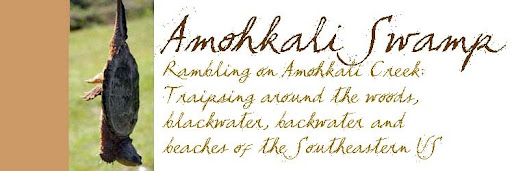Pictures from Bald Point, Florida trip - March 2014
We spent four days in a house on Bald Point, Florida last week. This state park is on the southwestern side of Ochlockonee Bay. It's the point where the bay opens into the Gulf. Find Panacea, Florida on the map, follow US 98 southwest, and there ya are.
Bald Point has a couple of dozen houses and nothing else, but is completely surrounded by
Bald Point State Park, which in turn is pretty much surrounded by
St. Mark's National Wildlife Refuge and the Gulf of Mexico. It's near several other state parks, two great clear-water kayaking rivers (the St. Marks upper portion and the Wakulla), and within easy driving distance to the award-winning St. George Island sugar sand beaches. You can eat in Panacea or at the bridge over the Ochlockonee Bay, or drive to Apalachicola for an evening.
We had a good weekend walking on the beach, paddling in black water (the lower Wakulla and Otter Lake Recreation area) watching birds, catching minnows in the brackish water, and eating good seafood. Since it's early spring, we saw a lot more snakes than usual, which is always cool.
A good many of these photos were shot with my Olympus water-resistant point and shoot camera, so the quality isn't great and they aren't meant to be art...
 |
| View Across the marsh. There's a bald eagle in the dead pine in the middle. |
Wandering around in the interior of the park, there were a good many deer - here's a pair of does (one behind the palmettos) that stood and watched me for a good while.
We had warm, sunny weather until the day we came home. Sunday was cloudy, cool and foggy. This view across the end of the bay, towards Mashes Beach, was within an hour of low tide. The oyster bars in the bay attract predatory fish and things that like to catch them (people and dolphin) like crazy.
Otter Lake Recreation Area in St. Mark's National Wildlife Refuge, near Panacea, FL. This cypress has a water oak growing out of a hollow in it.
One of the small jelly fish that wash up on the beach - the patterns are neat.
American Kestrel that visited us each morning. I couldn't tell if it had gotten wet from dew each night or from swimming or bathing, but it came to the dead tree in the back yard and preened every day.
I think Otter Lake Recreation Area should be renamed Osprey Lake. There are more nesting pairs of osprey there in the spring than I thought possible in such a small lake. This one was solo, but spent its time fussing at anything that moved around it.
A pair of osprey at the edge of the lake (sorry - this was my point and shoot waterproof camera)
A towhee near Chaire's Creek bridge in Bald Point State Park
A gnatcatcher??? on the point at Bald Point State Park.
I had good luck with snakes this weekend. This is a scarlet kingsnake (not a coral snake). Found under some wood in the scrub near Chaire's Creek bridge in Bald Point State Park. This little snake posed for me - you can see that the end of his nose is red - one way to tell a scarlet king from a coral snake. For a more thorough guide -
see the Florida Museum of Natural History site
Brown water snake on the Wakulla River, laying up on a tree in the water. A couple of other paddlers told us to be careful of the copperhead. This isn't one - notice the checkerboard patterns and the non-triangular head? Also, it was IN the water. Copperheads can swim, but prefer not to. This one was clearly living in the water. Not a great shot - my waterproof point and shoot doesn't like to be within three feet of the subject...
Tiny sparkleberry (wild blueberry) plants
Another type of wild blueberry - haven't figured out the species yet.


























